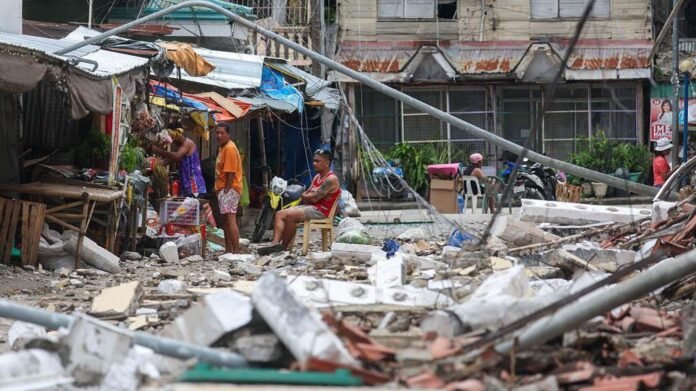Rescue operations were underway in the central Philippines on Wednesday after a powerful earthquake killed at least 69 people and left dozens trapped under collapsed houses and buildings in Cebu province. The 6.9-magnitude quake struck late Tuesday night, shaking the coastal city of Bogo and several nearby towns. Officials warned the death toll could rise as search efforts continue.
The quake, triggered by movement along an undersea fault line at a depth of just five kilometres, was one of the most powerful to hit the region in more than a decade. Its shallow depth caused widespread damage across Bogo, a city of around 90,000 residents, where about half of the fatalities have been reported. More deaths occurred in nearby towns, including Medellin and San Remigio, where victims included coast guard personnel, a firefighter, and a child.
Backhoes, sniffer dogs, and rescue teams were deployed to sift through rubble despite heavy rains, broken bridges, and landslide risks in mountain villages. “We’re still in the golden hour of our search and rescue,” said Bernardo Rafaelito Alejandro IV of the Office of Civil Defence. “There are still many reports of people pinned or struck by debris.”
The Philippine Institute of Volcanology and Seismology issued a tsunami warning shortly after the quake, but it was lifted within hours after no unusual waves were detected. More than 600 aftershocks were recorded, further rattling traumatised communities already battered by a tropical storm just days earlier that killed 27 people. Thousands spent the night in open fields and parks, unwilling to return to their damaged homes.
Schools and government offices in Cebu and surrounding provinces were closed while engineers inspected buildings. Officials also warned that rain-soaked slopes could trigger additional landslides.
Foreign governments, including the United States, Japan, Australia and the European Union, expressed condolences. US Ambassador MaryKay Carlson said Washington “stands ready to support the Philippine government’s response as friends, partners, allies.”
The Philippines, located on the seismically active Pacific “Ring of Fire,” is among the world’s most disaster-prone nations. The archipelago regularly experiences strong earthquakes, volcanic eruptions, and around 20 typhoons each year, making recovery efforts especially challenging for affected communities.



